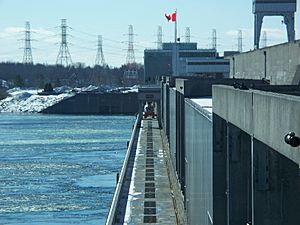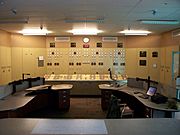Moses-Saunders Power Dam facts for kids
Quick facts for kids Moses-Saunders Power Dam |
|
|---|---|

The dam's R.H. Saunders Generating Station
|
|
|
Location of Moses-Saunders Power Dam in New York
|
|
| Official name | Robert Moses-Robert H. Saunders Power Dam |
| Country | United States/Canada |
| Location | Massena, New York Cornwall, Ontario |
| Coordinates | 45°00′23″N 74°47′42″W / 45.00639°N 74.79500°W |
| Status | Operational |
| Construction began | 1954 |
| Opening date | 1958 |
| Owner(s) | New York Power Authority Ontario Power Generation |
| Dam and spillways | |
| Impounds | Saint Lawrence River |
| Height | 195.5 ft (60 m) |
| Length | 3,216 ft (980 m) |
| Spillways | Long Sault Dam |
| Reservoir | |
| Creates | Lake St. Lawrence |
| Surface area | 100 sq mi (259 km2) |
| Maximum length | 30 mi (48 km) |
| Power station | |
| Commission date | R.H. Saunders: July 8, 1958-December 18, 1959 |
| Hydraulic head | 81 ft (25 m) |
| Turbines | R.H. Saunders: 16 x 65.3 MW fixed-pitch Kaplan-type St. Lawrence/FDR: 16 x 57 MW fixed pitch Kaplan-type |
| Installed capacity | R.H. Saunders: 1,045 MW St. Lawrence/FDR: 912 MW Total: 1,957 MW |
The Moses-Saunders Power Dam is a huge dam on the Saint Lawrence River. It sits right on the border between the United States and Canada. You can find it between Massena, New York, and Cornwall, Ontario.
This dam is super important because it helps create lots of clean energy. It sends water to two big power stations: the U.S. St. Lawrence-Franklin D. Roosevelt Power Project and Canada's R.H. Saunders Generating Station. Together, they make nearly 2,000 MW of power!
Built between 1954 and 1958, the dam also formed Lake St. Lawrence. It's a key part of the larger Saint Lawrence Seaway project. Besides making electricity, the dam helps control the St. Lawrence River. It also allows large ships to travel through, which is great for trade.
Even though the dam brought many benefits, it also caused some challenges. About 6,500 people had to move from their homes, and the environment was affected. But over the years, people have worked hard to improve the riverbanks and help fish habitats.
Contents
Building the Moses-Saunders Dam
The idea of developing the St. Lawrence River started a long time ago. In 1871, the Treaty of Washington helped set the river as a border. It also allowed Americans to use the Canadian side for shipping. Later, in 1895, a group was formed to see how the river could be used more for boats.
Shipping on the river would help trade between the U.S. and Canada. An early plan for the Saint Lawrence Seaway was suggested. But railway companies in the U.S. stopped it. They worried it would make them lose money.
Working Together on the River
In 1909, the Boundary Waters Treaty of 1909 made the U.S. and Canada work even closer. It said the river should be "free and open" for everyone. It also created the International Joint Commission (IJC) to solve any disagreements.
In 1931, New York's Governor Franklin D. Roosevelt signed a law. This law allowed the St. Lawrence River to be used for power. A great spot for a power plant was near the Long Sault Rapids.
However, political problems in the U.S. kept the river from being developed for a while. Canada got tired of waiting. In 1951, Canada decided to start projects on the St. Lawrence River by itself. These projects were for both power and shipping.
The U.S. saw this as a security risk. So, they pushed Canada to agree to a shared Seaway project. In 1952, a plan for a hydroelectric dam and navigation lock was finally approved.
Construction Begins
Even with approval, building didn't start until August 19, 1954. This was when the whole Seaway project officially began at the dam site. The construction was expected to take about seven years. The U.S. Army Corps of Engineers helped manage much of the work.
Robert Moses, who led the New York Power Authority, was in charge of the U.S. part. Robert Hood Saunders, who led Ontario Hydro, oversaw the Canadian side. The project included the main dam, the Long Sault Dam, and several locks and dikes.
Sadly, Robert Hood Saunders passed away in 1955. He died from injuries after a plane crash. He was only 51 and a very important leader. The Canadian power station was named after him.
On July 1, 1958, a big explosion happened. Workers used 27 metric tons of explosives to remove a temporary dam. This dam had kept river water away from the power plant construction. After four days, the plant was fully working. The last generators were ready in 1959.
Impacts of the Dam
While the dam brought many benefits, it also had some challenges for people and nature.
People Had to Move
To build the dam, about 6,500 people in Eastern Ontario had to leave their homes. These were mostly residents of six villages and three small communities. They are now known as The Lost Villages. Their land was flooded to create the new lake.
People were paid for their land. But some felt the prices were unfair because of the upcoming flood. Some residents were even forced to move. Most moved to new communities like South Stormont (Long Sault) or Ingleside and Iroquois. In 2008, Ontario Hydro apologized for what happened.
Impact on Indigenous Communities
The dam also affected the traditional lands of the Mohawk people of Akwesasne. Over 1,200 acres of their reserve lands were flooded. Plus, 15,000 acres of their traditional lands were also covered by water. The Mohawk people were not asked or paid for the flooding of their islands.
After 15 years of discussions, a settlement was reached in 2008. It included money, the return of some islands, and plans for environmental care.
Pollution Concerns
The cheap power from the dam attracted big factories to the area. Companies like General Motors and Reynolds Metals opened plants. But these factories caused serious pollution in the river. Today, some of these sites are part of special clean-up programs.
Environmental Effects on Fish
The flooding and pollution have impacted fish in the river and Lake St. Lawrence. Fish like Northern Pike, Walleye, Muskellunge, Lake Sturgeon, and American eel have been affected. Losing their natural spawning grounds (places where they lay eggs) has also caused their numbers to drop.
Good news! Recent efforts have helped fish populations grow or stay steady. The R.H. Saunders Generating Station even has a special "eel ladder." This ladder helps young American Eels travel upriver past the power station. It was once the tallest in the world! It has been made even longer recently.
Also, a program helps trap and move young eels downstream safely. From 2006 to 2011, about four million young eels crossed into the upper St. Lawrence River and Lake Ontario.
Both New York and Ontario have programs to improve the environment around the dam. They work on water quality and protecting habitats. The R.H. Saunders Generating Station also studies the environment. They improve habitats and adjust power production during fish spawning seasons. In 2016, a tracking system was installed to follow the migration of birds, bats, and even large insects.
Keeping the Dam Strong
Over time, dams need repairs and upgrades.
Repairs and Upgrades
In the early 1990s, engineers found problems with the dam's concrete and generators. The concrete was cracking because of a chemical reaction. From 1993 to 2001, major repairs were done to fix the concrete.
From 1987 to 2007, upgrades to the R.H. Saunders Generating Station made it 16 percent more efficient. In 1998, the New York Power Authority started a big project to fix their turbine-generators. This project was expected to be finished in 2013.
How the Dam Works
The Moses-Saunders Dam is about 195.5 ft (60 m) tall and 3,212 ft (979 m) long. It stretches between the Canadian shore and Barnhart Island in New York.
To create the large reservoir (Lake St. Lawrence), another dam called the Long Sault Dam was built upstream. This dam is 2,960 ft (902 m) long and 109 ft (33 m) high. It acts as a spillway to release extra water during floods.
The dam's power station has 32 turbine generators. Ontario Power Generation runs units 1-16, and the New York Power Authority runs units 17-32. These powerful turbines use the force of water falling 81 ft (25 m) to create electricity.
There are also locks nearby, like the Eisenhower and Snell Locks. These locks help large ships, up to 730 ft (223 m) long, pass through the river.




